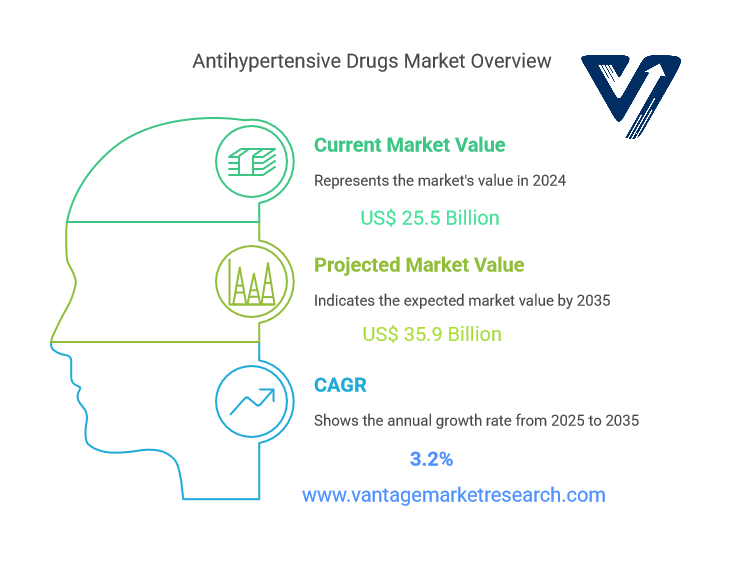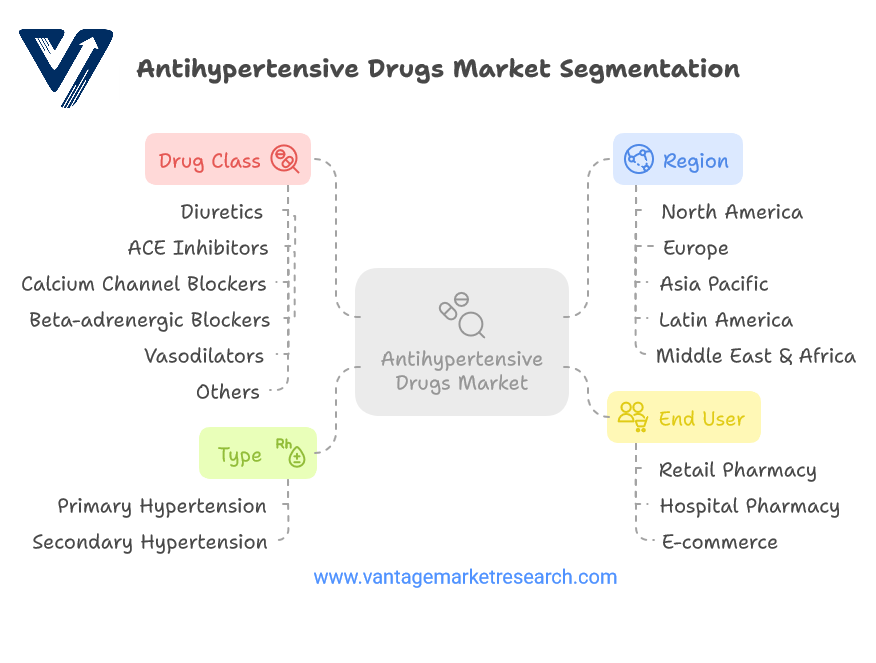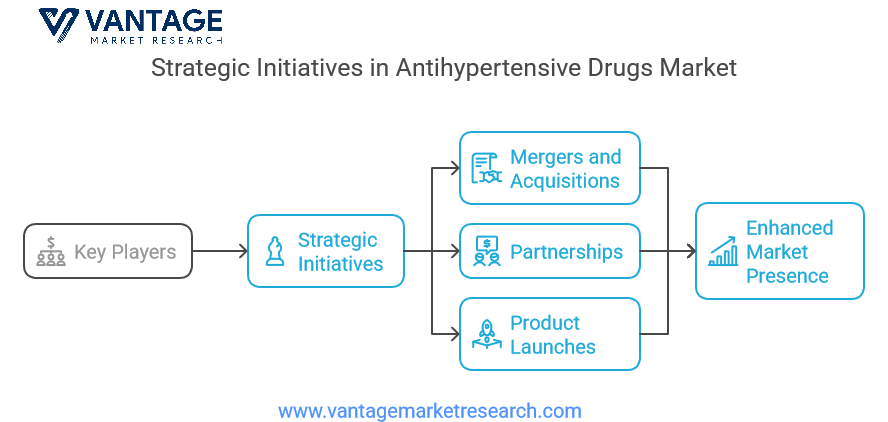
Analysis of The Antihypertensive Drugs Market Size | USD 35.9 Bn & CAGR 3.2% Growth By 2035
Antihypertensive Drugs Market Industry 2025-2035
This market research report delves into the Antihypertensive Drugs Market, projecting its growth and dynamics from 2025 to 2035. It provides a comprehensive overview of market trends, segmentation, competitive landscape, and future outlook. The report highlights key drivers, restraints, and emerging opportunities within the industry, offering valuable insights for stakeholders and investors. By analyzing various drug classes and end-user segments, this document aims to equip readers with a thorough understanding of the market's potential and challenges.
Antihypertensive Drugs Market Size and Forecast
Hypertension, commonly known as high blood pressure, is a significant global health concern affecting millions of individuals worldwide. The Antihypertensive Drugs Market plays a crucial role in managing this condition, which can lead to severe complications such as heart disease, stroke, and kidney failure if left untreated. The market for antihypertensive medications is expected to witness substantial growth from 2025 to 2035, driven by increasing prevalence rates of hypertension, advancements in drug formulations, and a growing aging population.
The significance of this report lies in its detailed analysis of the antihypertensive drugs market, providing insights into market dynamics, segmentation, competitive landscape, and future projections. Key findings indicate that the market is poised for growth due to rising awareness about hypertension management, the introduction of novel therapies, and the expansion of healthcare infrastructure in emerging economies. Additionally, the report identifies trends such as the shift towards personalized medicine and the increasing adoption of e-commerce platforms for drug distribution.
Download Sample Report PDF (Including Full TOC, Table & Figures) @ https://www.vantagemarketresearch.com/antihypertensive-drugs-market-2562/request-sample
According to analysts at Vantage Market Research, the global Antihypertensive Drugs Market is valued at USD 25.5 billion in 2024 and is projected to reach a value of USD 35.9 billion by 2035 at a CAGR (Compound Annual Growth Rate) of 3.2% between 2025 and 2035.

Market Dynamics
Growth Drivers
The antihypertensive drugs market is propelled by rising hypertension incidence linked to sedentary lifestyles, obesity, and aging demographics. By 2030, nearly 22% of the global population will be over 60, amplifying demand for chronic disease management. Technological advancements, such as AI-driven drug discovery and smart pill monitoring, further accelerate R&D efficiency. Government initiatives, like the WHO’s HEARTS program, also promote hypertension awareness and treatment accessibility.
The antihypertensive drugs market is primarily driven by the increasing prevalence of hypertension globally. According to the World Health Organization (WHO), nearly 1.13 billion people worldwide suffer from high blood pressure, with many unaware of their condition. This growing patient population necessitates effective treatment options, thereby propelling market growth. Furthermore, advancements in drug development, including the introduction of combination therapies and novel drug classes, are enhancing treatment efficacy and patient compliance.
Market Restraints & Challenges
Despite the positive growth outlook, the market faces several challenges. The high cost of innovative therapies may limit access for patients, particularly in low- and middle-income countries. Additionally, the availability of generic alternatives poses a threat to branded products, leading to price competition and reduced profit margins for pharmaceutical companies. Regulatory hurdles and the lengthy approval process for new drugs can also impede market growth.
Growth Opportunities & Emerging Trends
Emerging trends such as telemedicine and digital health solutions are creating new opportunities for the antihypertensive drugs market. The integration of technology in healthcare allows for better patient monitoring and adherence to treatment regimens. Moreover, the increasing focus on preventive healthcare and lifestyle modifications is expected to drive demand for antihypertensive medications. The rise of personalized medicine, which tailors treatment based on individual patient profiles, is another promising trend that could reshape the market landscape.
Regional Breakdown
- North America (35% market share): Driven by high healthcare expenditure and hypertension prevalence (48% of U.S. adults).
- Europe: Emphasis on cost-effective generics and EU-wide hypertension guidelines.
- Asia-Pacific (fastest CAGR: 6.1%): Urbanization, dietary shifts, and expanding insurance coverage.
- Latin America/MEA: Growing awareness campaigns and government partnerships.
The market dynamics vary across regions, with North America and Europe currently dominating the market due to advanced healthcare systems and high awareness levels. However, the Asia Pacific region is anticipated to witness the highest growth rate during the forecast period, driven by a large population base, increasing healthcare expenditure, and rising awareness about hypertension management.
Take Action Now: Secure Your Position in the Global Antihypertensive Drugs Industry Today – Purchase Now.
Segments Insights

The antihypertensive drugs market can be segmented by drug class, type, end-user, and region.
By Drug Class
- Diuretics: These are often the first-line treatment for hypertension and are expected to maintain a significant market share.
- ACE Inhibitors: Known for their effectiveness in managing hypertension, these drugs are widely prescribed.
- Calcium Channel Blockers: These medications are gaining traction due to their efficacy and safety profile.
- Beta-adrenergic Blockers: While traditionally used, their market share is declining as newer classes emerge.
- Vasodilators: These are used in specific cases and are expected to see moderate growth.
- Others: This category includes newer drug classes that are emerging in the market.
ACE Inhibitors and ARBs dominate the market with a 32% share due to their proven efficacy in treating diabetic patients. Calcium Channel Blockers are preferred for isolated systolic hypertension, particularly in elderly populations. Diuretics remain the first-line therapy due to their cost-effectiveness, while Vasodilators are used in niche applications, particularly for resistant hypertension.
By Type
- Primary Hypertension: This segment dominates the market, accounting for the majority of cases.
- Secondary Hypertension: Although less common, this segment is growing due to increased diagnosis rates.
Primary Hypertension, which accounts for 85% of cases, is primarily linked to lifestyle factors such as diet, exercise, and stress levels. Secondary Hypertension, on the other hand, is driven by renal and endocrine disorders, requiring more specialized therapeutic approaches.
By End User
- Retail Pharmacy: The most common distribution channel for antihypertensive drugs.
- Hospital Pharmacy: A significant segment, especially for acute care settings.
- E-commerce: This segment is rapidly growing, driven by the convenience of online shopping.
Hospital pharmacies hold a dominant 45% market share, driven by a high dependency on prescription-based treatments. E-commerce has seen rapid growth, with a 12% compound annual growth rate (CAGR) post-pandemic, primarily fueled by the rise of online pharmacy platforms.
By Region
- North America: Holds the largest market share due to high healthcare spending.
- Europe: A mature market with a focus on innovative therapies.
- Asia Pacific: Expected to grow rapidly due to increasing healthcare access and awareness.
- Latin America: A developing market with potential for growth.
- Middle East & Africa: Emerging markets with increasing healthcare investments.
North America holds a 35% market share, influenced by high healthcare expenditure and the widespread prevalence of hypertension, affecting 48% of U.S. adults. Europe places emphasis on cost-effective generics and adheres to EU-wide hypertension treatment guidelines. The Asia-Pacific region exhibits the fastest growth, with a CAGR of 6.1%, driven by urbanization, dietary changes, and expanded insurance coverage. In Latin America and the Middle East & Africa, growing awareness campaigns and government partnerships are helping to drive market growth.
For the Antihypertensive Drugs Market Research Report and updates, view the full report now!
Competitive Landscape
The competitive landscape of the antihypertensive drugs market is characterized by the presence of several key players, including Novartis AG, AstraZeneca plc, Lupin, Daiichi Sankyo Company, Limited, Johnson & Johnson, Pfizer Inc., Sun Pharmaceutical Industries Ltd., SANOFI, Boehringer Ingelheim International GmbH, and Merck & Co. Inc. These companies are focusing on strategic initiatives such as mergers and acquisitions, partnerships, and product launches to enhance their market presence.
For instance, Novartis AG has been actively involved in research and development to introduce innovative therapies that address unmet medical needs. AstraZeneca plc has expanded its portfolio through strategic collaborations, while Pfizer Inc. continues to invest in clinical trials to validate the efficacy of its antihypertensive products. The competitive strategies of these players are crucial in shaping the market dynamics and influencing consumer choices.

Top 11 Companies in Antihypertensive Drugs Industry
- Novartis AG.
- AstraZeneca plc
- Lupin
- Daiichi Sankyo Company
- Limited
- Johnson & Johnson
- Pfizer Inc.
- Sun Pharmaceutical Industries Ltd.
- SANOFI
- Boehringer Ingelheim International GmbH
- Merck & Co. Inc
Report Coverage
This report provides a comprehensive analysis of the antihypertensive drugs market, covering various aspects such as market dynamics, segmentation, competitive landscape, and future outlook. It includes detailed insights into growth drivers, restraints, opportunities, and emerging trends. The report also features case studies and real-world examples to illustrate key findings and market trends. The data presented is based on extensive research and analysis, ensuring accuracy and relevance for stakeholders and decision-makers.
Conclusion and Future Outlook
In conclusion, the antihypertensive drugs market is poised for significant growth from 2025 to 2035, driven by increasing prevalence rates of hypertension, advancements in drug development, and a growing aging population. While challenges such as high costs and regulatory hurdles exist, emerging trends like telemedicine and personalized medicine present new opportunities for market expansion. Stakeholders are encouraged to leverage these insights to navigate the evolving landscape and capitalize on growth opportunities in the antihypertensive drugs market. Future projections indicate a robust market, with potential for innovative therapies to transform hypertension management and improve patient outcomes.
FAQ.
- What are the key drivers behind the increasing demand for antihypertensive drugs in the global market?
- Which drug classes are experiencing the highest growth in the antihypertensive drugs market?
- How is the rise of online pharmacy platforms impacting the distribution of antihypertensive drugs?
- What role do generics play in the antihypertensive drugs market, particularly in Europe and other cost-conscious regions?
- What are the current market trends in the treatment of resistant hypertension, and how are new drugs addressing this condition?
- How has the COVID-19 pandemic affected the worldwide sales and distribution of antihypertensive medications?
- What are the key regional differences in the prevalence of hypertension, and how are pharmaceutical companies tailoring their strategies to these regions?
- How are advancements in drug formulations and combination therapies influencing the market for antihypertensive drugs?
- What are the main challenges faced by the antihypertensive drugs market, particularly regarding pricing and accessibility?
- How are government initiatives and healthcare policies in emerging markets like Asia-Pacific and Latin America contributing to the growth of the antihypertensive drugs sector?
Browse More Health Care Industry News
- The global Personalized Medicine Marketis valued at USD 550.2 Billion in 2024 and is projected to reach a value of USD 1302.7 Billion by 2035 at a CAGR (Compound Annual Growth Rate) of 15% between 2025 and 2035.
- The global Digital Health Market is valued at USD 288.55 Billion in 2024 and is projected to reach a value of USD 2688 Billion by 2035 at a CAGR (Compound Annual Growth Rate) of 22.55% between 2025 and 2035.
- According to analysts at Vantage Market Research, the Global Weight Loss Drugs Marketis expected to be valued at USD 2.88 billion in 2024. It is projected to reach a value of USD 142.5 billion by 2035 at a CAGR (Compound Annual Growth Rate) of 42.5% between 2025 and 2035.
- According to analysts at Vantage Market Research, the Global Nutraceuticals Market was valued at USD 490.24 billion in 2022 and is projected to reach a value of USD 955.52 billion by 2030, at a CAGR of 8.70% over the forecast period.
- According to analysts at Vantage Market Research, the global Genomics in Cancer Care Market is valued at US$ 24.5 Billion in 2024 and is projected to reach a value of US$ 131.7 Billion by 2035 at a CAGR of 16.55% between 2025 and 2035.

Editor Details
-
Company:
- VMR
-
Name:
- Rahul
- Email:
-
Telephone:
- +12129511369
Related Links
- Website: Antihypertensive Drugs Market
